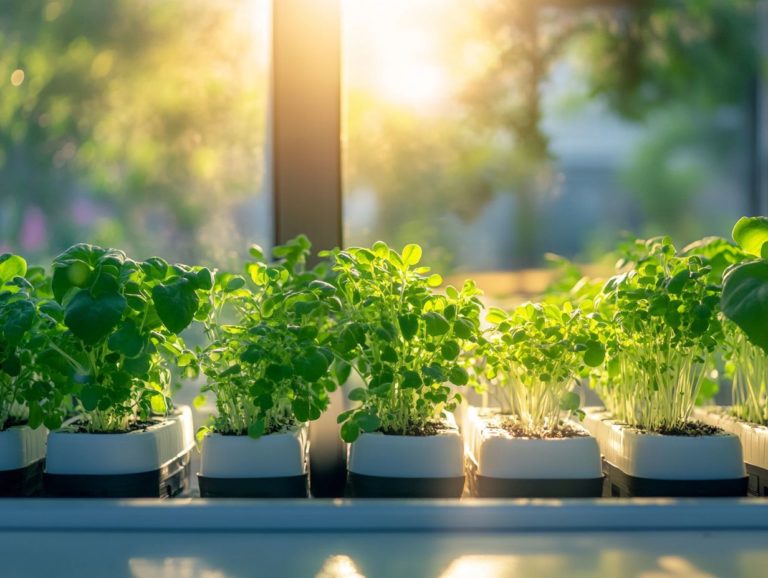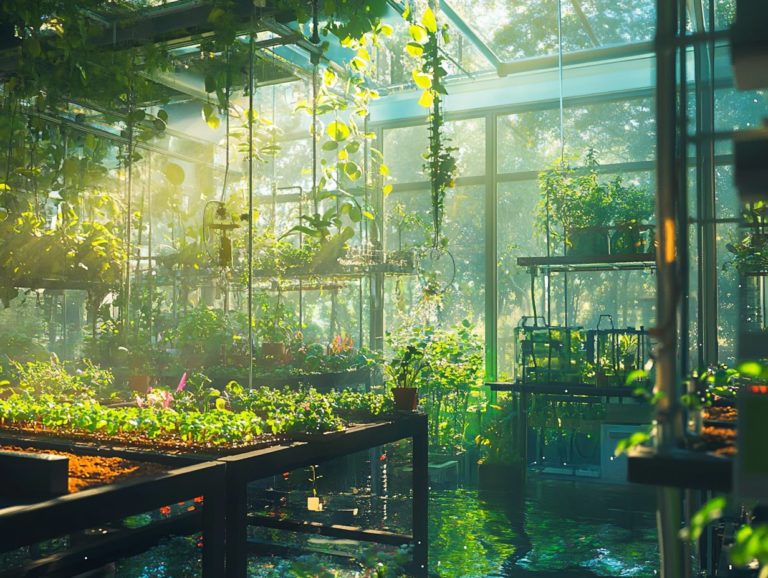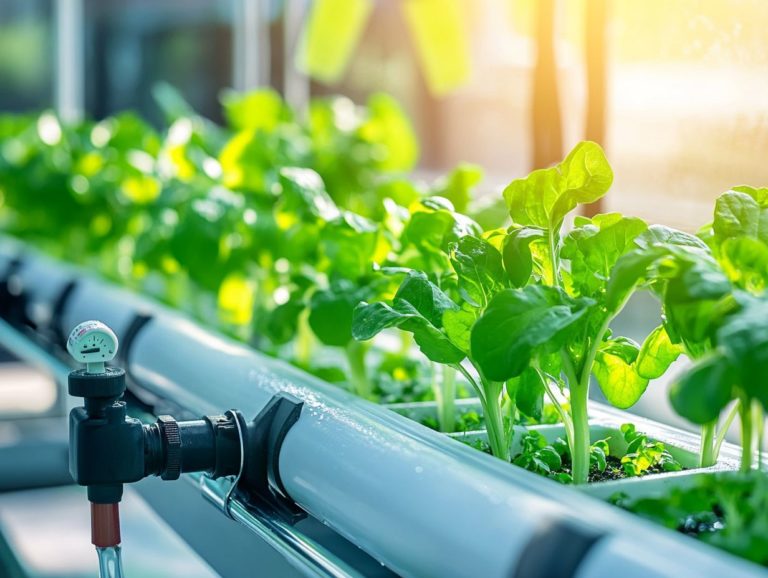How to Enhance Your Hydroponic System’s Efficiency
Hydroponic systems offer a revolutionary way to grow plants. Maximizing their efficiency is key to achieving great results.
This article explores how to improve your hydroponic setup. You ll learn about nutrient delivery, light, and water use.
Discover the factors to consider, the best plants to choose, and practical maintenance tips. These insights will help you cultivate a thriving hydroponic garden.
Contents
- Key Takeaways:
- Benefits of Enhancing Efficiency
- Factors Affecting Efficiency
- Enhancing Nutrient Delivery
- Maximizing Light and Water Usage
- Strategies for Efficient Lighting and Watering
- Choosing the Right Plants and Techniques
- Plant Selection and Growing Methods
- Maintenance and Troubleshooting Tips
- Frequently Asked Questions
- What is a hydroponic system and how can I enhance its efficiency?
- Why is it important to regularly check and maintain a hydroponic system?
- How can I improve lighting in my hydroponic system?
- What is the ideal temperature for a hydroponic system?
- How can I balance the nutrient solution in my hydroponic system?
- Can I use organic nutrients in a hydroponic system?
Key Takeaways:

- Regular maintenance is vital for an efficient hydroponic system.
- Choosing the right plants and optimizing nutrient delivery boosts efficiency.
- Strategic methods can maximize light and water usage.
Understanding the Basics
Understanding hydroponics is crucial for anyone aiming to improve crop yield. It uses a nutrient solution to grow plants without soil, offering a modern alternative to traditional farming.
Hydroponics is great for urban farming where space is limited. It allows for fresh produce all year round.
By knowing the basics, you can make informed choices. You ll optimize your growing techniques and increase your output.
Nutrient solutions are beneficial, as they control what your plants absorb, enhancing growth and flavor. Systems like nutrient film method, aeroponics, and deep water culture have unique benefits.
These methods help reduce water use, minimize pesticides, and lessen land disruption. They play a key role in sustainable agriculture.
Benefits of Enhancing Efficiency
Improving efficiency in hydroponics brings many benefits. Expect higher crop yields, better nutrient levels, and superior resource management.
With effective fertilizer programs, you can increase output while conserving water. These enhancements also lead to better plant health.
Why Optimize Your Hydroponic System?
Optimizing your hydroponic system is vital for higher crop yields. It ensures that your plants receive effective nutrient solutions.
This process reduces energy use and the risk of pests. It promotes a healthy environment for plants, maximizing your returns.
You can adjust variables like light intensity, temperature, and humidity. Monitoring nutrient concentrations ensures robust plant growth.
Using energy-efficient systems cuts costs and promotes sustainability. Integrating pest management strategies protects your crops, leading to healthier harvests.
Factors Affecting Efficiency
Several factors influence the efficiency of hydroponic systems. Key elements include nutrient availability, light exposure, pH levels, and nutrient concentrations.
Understanding how these elements impact plant growth is crucial for anyone aiming to optimize hydroponic techniques. This knowledge helps you achieve peak crop yields.
By fine-tuning these variables, you can enhance plant health and create effective nutrient recipes tailored to your crops. This ultimately boosts agricultural output.
Key Elements to Consider

When optimizing a hydroponic system, there are crucial elements to keep in mind that will significantly influence its success. Consider factors like nutrient solutions, light exposure, and water efficiency.
Effective pest and disease management strategies safeguard your crops and enhance their resilience. These strategies are vital for maintaining plant health and achieving high crop yields.
The relationship between nutrient solutions and plant growth is critical. The specific ratios of large nutrients (macro) and small nutrients (micronutrients) you choose will directly impact crop vitality.
Light exposure is another game-changer. The quality and duration of light you provide will affect photosynthesis, which in turn influences growth rates and overall yield.
Water efficiency cannot be overlooked. Optimizing your system to minimize waste while maximizing plant uptake creates a more sustainable cycle.
Tackling potential pests and diseases through integrated pest management techniques nurtures a healthier hydroponic ecosystem. This approach helps your plants thrive even in the face of challenges.
Enhancing Nutrient Delivery
Enhancing nutrient delivery is essential for your hydroponic gardening success and maximizing crop production. It ensures that your plants receive the essential nutrients they need in the right concentrations.
By improving nutrient uptake through various methods, you can significantly elevate plant health and yield. This process involves regular nutrient replenishment and vigilant monitoring of nutrient levels to prevent deficiencies.
Ultimately, this results in a more robust agricultural output.
Methods for Improving Nutrient Uptake
Several methods are at your disposal for enhancing nutrient uptake in hydroponic systems. By optimizing nutrient absorption and ensuring compatibility among various fertilizers, you can significantly elevate the performance of your plants.
Regularly adjusting your fertilizer regimen and employing customized nutrient recipes tailored to specific plant needs will enhance the effectiveness of nutrient delivery.
These practices are essential for maintaining high nutrient levels, ultimately aiding in better plant health and maximizing yields.
Incorporating techniques like aeroponics, where plants grow in air with mist for hydration, can dramatically boost oxygen availability. This promotes more efficient nutrient absorption.
Integrating micronutrients with your large nutrient solutions is vital as these elements provide a balanced diet necessary for robust growth.
Fine-tuning pH levels to meet the specific requirements of your crops will further enhance nutrient solubility, facilitating optimal uptake.
By leveraging advanced nutrient compatibility strategies and routinely assessing the composition of your nutrient solution, you can cultivate a more harmonious environment.
This approach fosters vigorous plant development and drives healthy, abundant yields, ensuring your hydroponic endeavors thrive.
Maximizing Light and Water Usage
Maximizing your light and water usage is crucial for the efficiency of hydroponic systems, especially when employing artificial lighting and vertical setups.
Ensuring effective light exposure is key to adequate photosynthesis. At the same time, optimizing water efficiency lowers costs and boosts plant health.
By concentrating on these elements, you can significantly reduce energy consumption and enhance the overall sustainability of your hydroponic gardening endeavors. For more detailed insights, check out how to optimize your hydroponic layout and unlock the full potential of your hydroponic system!
Strategies for Efficient Lighting and Watering
Implementing effective strategies for efficient lighting and watering is crucial for your hydroponic success. Ideal light exposure can be easily managed with LED technology. Advanced watering techniques ensure your plants get just the right amount of moisture.
Choosing the right light spectrum is essential. Different growth stages demand varying wavelengths for best growth. Use adjustable light schedules and timers to boost energy efficiency.
On the watering front, methods like aeroponics or misting systems provide precise moisture delivery. This reduces waste and ensures your plants are perfectly hydrated neither overwatered nor underwatered.
These techniques promote vigorous plant growth while cutting down on operational costs. This makes your hydroponic systems more sustainable and commercially viable.
Choosing the Right Plants and Techniques

Choosing the right plants and techniques is vital for your success in hydroponics. Different crops have unique nutrient needs and growth patterns. Selecting varieties that thrive in controlled environments is key.
This thoughtful process optimizes your crop production and leverages the environmental benefits of hydroponics. Healthier plants enhance agricultural output across various systems.
Plant Selection and Growing Methods
When selecting plant varieties for your hydroponic systems, consider the specific growing methods and nutrient solutions. Crops like lettuce and tomatoes thrive in hydroponic environments, making them great choices for beginners.
Embracing sustainable practices and understanding each plant’s needs leads to successful outcomes. This will elevate your crop production.
Besides lettuce and tomatoes, think about adding herbs like basil and cilantro. These herbs flourish in nutrient-rich water and are easy to manage in different hydroponic setups.
Customize nutrient solutions to meet each plant’s specific needs. For example, leafy greens require higher nitrogen levels, while fruiting plants benefit from a mix that includes potassium for the best yields.
Diverse plant varieties enhance biodiversity and maximize your space and resources, aligning perfectly with sustainable agriculture principles.
Maintenance and Troubleshooting Tips
Regular maintenance and effective troubleshooting are essential for your hydroponic systems’ longevity and success. Diligently monitor nutrient levels and implement pest management strategies to prevent issues impacting plant health and crop yield.
Understanding how to address common challenges paves the way for smoother operations. This ultimately enhances your hydroponic experience and maximizes productivity.
Keeping Your System Running Smoothly
Keeping your hydroponic system running smoothly requires regular checks, nutrient replenishment, and effective pest control measures. By monitoring environmental conditions and ensuring that your nutrient solutions are consistently topped up, you can maintain optimal plant health.
Implement solid pest control strategies to shield your crops from infestations. This approach ensures a successful and sustainable hydroponic gardening experience. Regularly inspecting your system for clogs or leaks and knowing how to maintain hydroponic equipment can prevent significant setbacks.
Adjusting pH levels and the ability of water to conduct electricity will ensure your plants receive the right nutrient balance. Environmental factors like temperature and humidity should be closely monitored, as they play a crucial role in plant growth.
Utilizing integrated pest management techniques like introducing beneficial insects or using organic pesticides can further elevate your pest control efforts. By staying vigilant and proactive, you can cultivate a thriving environment that promotes healthy plant development and maximizes your yield.
Frequently Asked Questions
What is a hydroponic system and how can I enhance its efficiency?

A hydroponic system is a method of growing plants without soil, using a nutrient-rich solution instead. To enhance its efficiency, regularly check and maintain the system, provide adequate lighting and temperature control, and properly balance the nutrient solution.
Why is it important to regularly check and maintain a hydroponic system?
A well-maintained hydroponic system ensures that plants receive the proper amount of nutrients and water. This leads to healthier and more efficient growth. Regular maintenance helps prevent potential issues that may arise in the system.
How can I improve lighting in my hydroponic system?
Investing in high-quality grow lights can greatly enhance the efficiency of your hydroponic system. Choose lights appropriate for the type of plants you are growing, and adjust the distance and timing of the lights according to their needs.
What is the ideal temperature for a hydroponic system?
The ideal temperature for a hydroponic system varies depending on the type of plants you are growing. Generally, it should be between 65-75 F. Maintaining a consistent temperature is important for the overall health and growth of your plants.
How can I balance the nutrient solution in my hydroponic system?
To ensure the proper balance of nutrients for your plants, regularly test the pH and nutrient levels in the solution. Adjust as needed to maintain the ideal levels for your specific plants.
Can I use organic nutrients in a hydroponic system?
Yes, there are organic nutrient solutions available for use in hydroponic systems. However, it is important to research and carefully select products that are suitable for hydroponic growing and will not clog or damage the system.
Get ready to enjoy a bountiful harvest! Start implementing these tips today!






